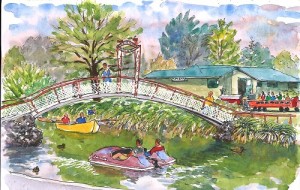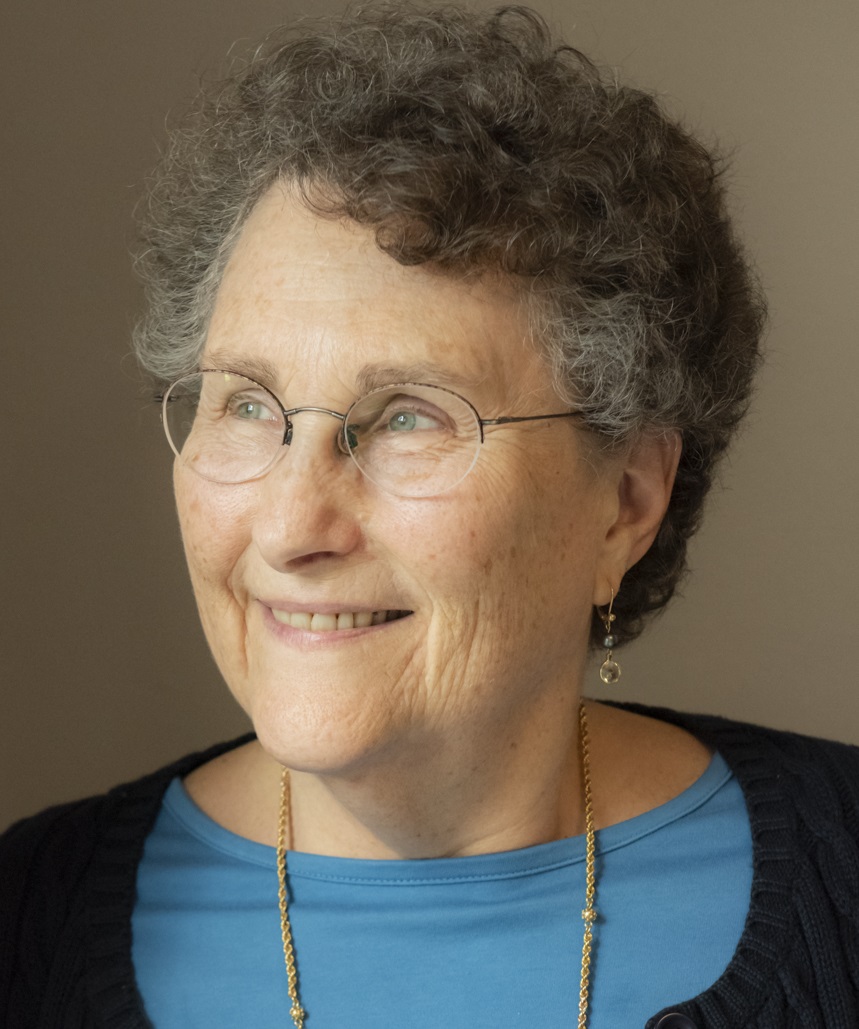Draw Near: Praying for trust and prayer as trust
Lynne Baab • Tuesday November 22 2022

If you’ve ever visited Trafalgar Square in London and looked toward the National Gallery, you might have noticed a church off to the right. That is St-Martin-in-the-Fields, where Rev. Samuel Wells is the vicar. He was previously the Dean at Duke University Chapel, and he is one of my favorite columnists in The Christian Century. I love it when he writes about the challenges of serving a church in central London, often full of tourists. I also enjoy his reflections on what our Christian faith looks like in practice.
In a recent column, Rev. Wells argues that there are two kinds of faith: belief and trust. Belief, he argues, focuses on certainty and conviction. He thinks that when we focus on belief, we often beat ourselves up when we can’t generate the kind of certainty we expect of ourselves or that we think others expect of us. Trust, as he describes it, is quite different:
“Trust doesn’t assume life is about overcoming limitations. It’s about finding truth, beauty, and friendship in the midst of those limitations. Trust doesn’t think that if you wave a magic wand, things will change overnight. It finds companionship in the community of the waiting. Trust doesn’t pretend that if you hold tight to the right things, nothing will ever go wrong. It inhabits the exercises and patience required to rebuild after matters have been strained or broken.” [1]
This has profound relevance to the way we pray. If trust is about “finding truth, beauty, and friendship in the midst of limitations,” then we can ask for God’s help to find those lovely things. We can ponder, in God’s presence, the pattern of our lives and ask for help in seeking activities that nurture truth, beauty, and friendship.
If trust is finding “companionship in the community of the waiting,” then we can affirm the significance – and even value – of waiting and ask for the Holy Spirit’s guidance and power to wait more graciously and patiently. We can ask for Jesus’ companionship with us in those too frequent situations when we must wait. We can also ask for the Holy Spirit’s nudging of where to look for human companionship. We can ask for the ability to convey to others our willingness to wait with them. We can try to grow in our willingness to wait even as we pray, to grow bit by bit in practicing silence and stillness in prayer.
If trust “inhabits the exercises and patience required to rebuild after matters have been strained or broken,” we can ask for the Holy Spirit’s empowering to help us patiently work on rebuilding broken relationships and systems. We can ask for God’s help to identify the ways our spiritual practices are strengthening us for rebuilding, and we can pray for help in identifying new spiritual practices that might help us grow in trust.
Maybe Rev. Wells’s article, entitled “The Better Part of Faith,” spoke to me so much because trust is a challenge for me. My spiritual director in the early 2000s told me multiple times to notice whether or not I was trusting God in various situations. I had never focused very much on the idea of trust until I began meeting with her. My Christian heritage as a child was God’s power and mystery, and I’m intensely grateful for what I learned as a child in Episcopal and Anglican churches about God’s majestic power, beauty and mystery. As a young adult my faith was deeply cognitive. I had so much fun diving into the rich intellectual tradition surrounding study of the Bible and theology. These Christian strands are vitally significant to me.
All too often today, however, the key issue for me is trust in this wonderful God who came to earth in Jesus to walk with us. Rev. Wells argues that trust focuses on building relationship with God and with others, so we can speak honestly to our loving companion, Jesus: “There are going to be setbacks, misunderstandings, and patient rebuilding. But I only want to be with you.” We may also say those words to our companions on the journey.
Rev. Wells concludes his article with a vivid picture:
“The Christian faith is really about trust. It’s not about Jesus the magician whisking us away on a magic carpet of happiness and glory. It’s about facing the unknown and seeing Jesus turn around, offer us his hand, and say, ‘We’re going to walk across the unknown together.’”
Prayer involves placing our hand in Jesus’ hand. Therefore prayer itself is an act of trust because in prayer we turn from our self-sufficiency and busyness toward the One who loves us. And prayer is a place where we can ask for more trust.
(Next week: Prayer and desire. Illustration by Dave Baab: Queen Elizabeth Park, Masterton, New Zealand. If you’d like to receive an email when I post on this blog, sign up under “subscribe” below.”)
A previous posts on trust: Trust and obey for there’s no other way
Additional related posts:
- Freedom from fear of death
- Why journey works so well as a metaphor for faith
- Benedictine spirituality: The first vow
[1] All quotations in this post are from “The Better Part of Faith” by Samuel Wells, The Christian Century, November 2022, 34.
Next post »« Previous post
Subscribe to updates
To receive an email alert when a new post is published, simply enter your email address below.

Lynne M. Baab, Ph.D., is a teacher and writer. She has written numerous books, Bible study guides, and articles for magazines and journals. Lynne is passionate about prayer and other ways to draw near to God, and her writing conveys encouragement for readers to be their authentic selves before God. She encourages experimentation and lightness in Christians spiritual practices. Read more »
Lynne is pleased to announce the release of her book on grief and gratitude, designed to help people grieving from anything, including the pandemic, while also desiring to notice God's good gifts. Two Hands: Grief and Gratitude in the Christian Life is available in paperback, audiobook, and for kindle. Lynne's 2018 book is Nurturing Hope: Christian Pastoral Care for the Twenty-First Century, and her best-selling book is Sabbath-Keeping: Finding Freedom in the Rhythms of Rest (now available as an audiobook as well as paperback and kindle). You can see her many other book titles here, along with her Bible study guides.
Lynne recently spoke about empathy and also about bringing spiritual practices to life.
Lynne was interviewed recently for the podcast "As the Crow Flies". The first episode focuses on why listening matters and the second one on listening skills.
Here are two talks Lynne gave on listening (recorded in audio form on YouTube): Listening for Mission and Ministry and Why Listening Matters for Mission and Ministry.
"Lynne's writing is beautiful. Her tone has such a note of hope and excitement about growth. It is gentle and affirming."
— a reader
"Dear Dr. Baab, You changed my life. It is only through God’s gift of the sabbath that I feel in my heart and soul that God loves me apart from anything I do."
— a reader of Sabbath Keeping
Subscribe
To receive an email alert when a new post is published, simply enter your email address below.
Featured posts
- Drawing Near to God with the Heart: first post of a series »
- Quotations I love: Henri Nouwen on being beloved »
- Worshipping God the Creator: the first post of a series »
- Sabbath Keeping a decade later: the first post of a series »
- Benedictine spirituality: the first post of a series »
- Celtic Christianity: the first post of a series »
- Holy Listening »
- A Cat with a Noble Character »
- Welcome to my website »
Tags
Archive
- April 2024 (4)
-
March 2024 (5)
- Friendship, loneliness, and prayer: Praying about distractions from empathy
- Friendship, loneliness, and prayer: Praying to keep empathy flowing
- Friendship, loneliness, and prayer: Everyday initiative
- Friendship, loneliness, and prayer: Praying for guidance for ending conversations
- Friendship, loneliness, and prayer: Reflecting on the series
- February 2024 (4)
- January 2024 (2)
-
December 2023 (6)
- Friendship, loneliness, and prayer: Initiating
- Friendship, loneliness, and prayer: Praying about listening roadblocks
- Friendship, loneliness, and prayer: Praying to love the poverty in our friends
- Friendship, loneliness, and prayer: Praying for “holy curiosity”
- Friendship, loneliness, and prayer: Praying for “holy listening”
- Friendship, loneliness, and prayer: Praying to give affection extravagantly
- November 2023 (4)
-
October 2023 (5)
- Friendship, loneliness and prayer: A listening skill with two purposes
- Friendship, loneliness, and prayer: Saying “thank you” to friends
- Friendship, loneliness, and prayer: One more way reflecting helps us
- Friendship, loneliness, and prayer: Lessons from two periods of loneliness
- Friendship, loneliness, and prayer: Types of reflecting, a listening skill
- September 2023 (4)
- August 2023 (4)
- July 2023 (5)
- June 2023 (3)
- May 2023 (6)
- April 2023 (4)
- March 2023 (4)
- February 2023 (4)
- January 2023 (4)
- December 2022 (5)
- November 2022 (1)
- October 2022 (5)
- September 2022 (5)
-
August 2022 (6)
- Draw near: Confessing sin without wallowing
- Draw near: A favorite prayer about peace, freedom, and much more
- Drawing near with Desmond Tutu: God’s love is the foundation for prayer
- Draw near: Worshipping God with Desmond Tutu
- Draw near: Yearning, beseeching and beholding with Desmond Tutu
- Draw near: Praising God with Desmond Tutu
- July 2022 (2)
- June 2022 (6)
- May 2022 (5)
- April 2022 (6)
- March 2022 (5)
- February 2022 (4)
- January 2022 (3)
- December 2021 (5)
- November 2021 (4)
- October 2021 (5)
- September 2021 (4)
- August 2021 (4)
- July 2021 (4)
- June 2021 (4)
- May 2021 (4)
- April 2021 (5)
- March 2021 (4)
- February 2021 (4)
- January 2021 (4)
- December 2020 (5)
- November 2020 (3)
- October 2020 (5)
- September 2020 (4)
- August 2020 (4)
- July 2020 (5)
- June 2020 (4)
-
May 2020 (4)
- Spiritual diary of sheltering in place: The lifeline of separating thoughts from feelings
- Spiritual diary of sheltering in place: The lifeline of welcoming prayer
- Spiritual diary of sheltering in place: a kite string as a lifeline
- Spiritual diary of sheltering in place: The lifeline of God’s distant future
-
April 2020 (7)
- Spiritual diary of self-isolation: the lifeline of God’s constancy
- Spiritual diary of sheltering in place: The lifeline of accepting my place as a clay jar
- Spiritual diary of sheltering in place: the lifeline of memories
- Spiritual diary of sheltering in place: the lifeline of “Good” in “Good Friday”
- Spiritual diary of sheltering in place: The lifeline of “easier does not mean easy”
- Spiritual diary of sheltering in place: The lifeline of nature
- Spiritual diary of sheltering in place: the lifeline of God’s voice through the Bible
-
March 2020 (7)
- Important anniversaries in 2020: The first Earth Day in 1970
- Important anniversaries in 2020: Florence Nightingale was born in 1820
- Spiritual diary of self-isolation: Weeks 1 and 2
- Spiritual diary of self-isolation: God's grace as a lifeline
- Spiritual diary of self-isolation: The lifeline of limits on thoughts
- Spiritual diary of self-isolation: Wrestling with God for a blessing
- Spiritual diary of self-isolation: responding to terror by listening to Jesus voice
- February 2020 (4)
- January 2020 (5)
- December 2019 (4)
- November 2019 (4)
- October 2019 (5)
- September 2019 (4)
- August 2019 (5)
- July 2019 (4)
- June 2019 (4)
- May 2019 (5)
- April 2019 (4)
- March 2019 (4)
- February 2019 (4)
-
January 2019 (5)
- Nurturing friendships in a cellphone world: Jesus as Friend
- Nurturing friendships in a cellphone world: Friendship with Christ and friendship with others
- Nurturing friendships in a cellphone world: Who is my neighbor?
- Nurturing friendships in a cellphone world: Friendship as action
- Nurturing friendships in a cellphone world: Hymns that describe friendship with God
- December 2018 (3)
-
November 2018 (5)
- Connections between the Bible and prayer: Sensory prayer in Revelation
- First post in a new series: Nurturing friendships in a cellphone world
- Nurturing friendships in a cellphone world: Strong opinions and responses
- Nurturing friendships in a cellphone world: My conversation partners about friendship
- Nurturing friendships in a cellphone world: Two views about communication technologies
- October 2018 (4)
- September 2018 (4)
-
August 2018 (5)
- Providing Christian Care in Our Time
- Providing Christian care in our time: Seven trends in pastoral care today
- Providing Christian Care in Our Time: Skills for Pastoral Care
- Providing Christian care: The importance of spiritual practices
- First post in a new series: Connections between the Bible and prayer
- July 2018 (4)
- June 2018 (4)
- May 2018 (5)
- April 2018 (4)
- March 2018 (5)
- February 2018 (4)
- January 2018 (4)
- December 2017 (5)
- November 2017 (4)
- October 2017 (4)
- September 2017 (5)
- August 2017 (4)
- July 2017 (4)
- June 2017 (4)
-
May 2017 (5)
- My new spiritual practice: Separating thoughts from feelings
- My new spiritual practice: Feeling the feelings
- My new spiritual practice: Coping with feelings that want to dominate
- My new spiritual practice: Dealing with “demonic” thoughts
- My new spiritual practice: Is self-compassion really appropriate for Christians?
- April 2017 (4)
- March 2017 (5)
- February 2017 (4)
- January 2017 (4)
- December 2016 (5)
- November 2016 (4)
- October 2016 (4)
- September 2016 (5)
- August 2016 (4)
- July 2016 (4)
- June 2016 (4)
- May 2016 (5)
- April 2016 (4)
- March 2016 (5)
- February 2016 (4)
- January 2016 (4)
- December 2015 (4)
- November 2015 (4)
- October 2015 (5)
- September 2015 (4)
- August 2015 (4)
- July 2015 (4)
- June 2015 (4)
- May 2015 (4)
- April 2015 (6)
- March 2015 (4)
- February 2015 (4)
- January 2015 (4)
- December 2014 (5)
- November 2014 (4)
- October 2014 (4)
- September 2014 (4)
- August 2014 (5)
- July 2014 (4)
- June 2014 (7)





















